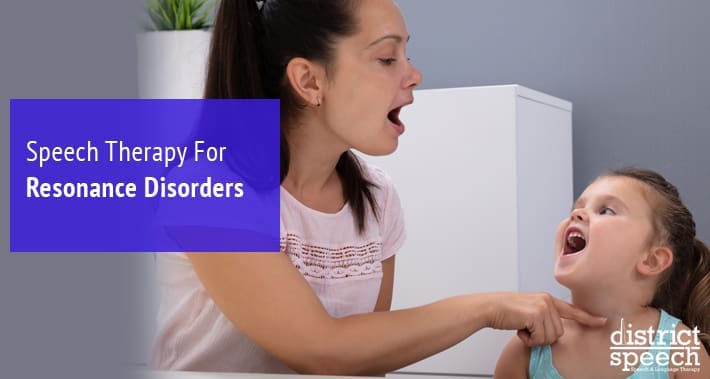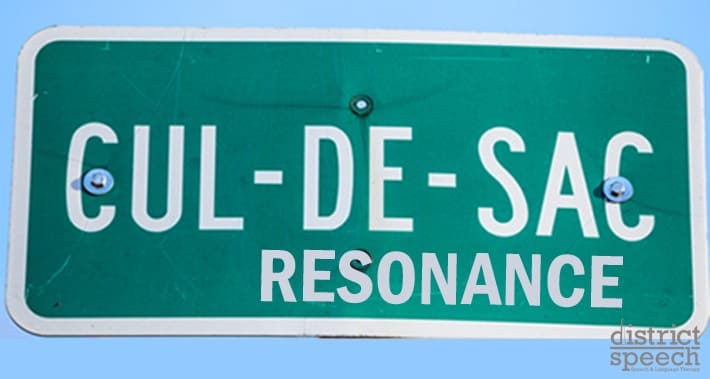
How many times per day do you use your voice to speak?
The answer is likely too many times to count.
Speaking out loud is an essential component of communication for most people.
It’s one of the many ways that we as people connect with each other.
Speech disorders interfere with this ability and, when left untreated, can lead to a wide range of communication impairments.
Resonance disorders are one such example.
People with resonance disorders are often told that their voices are “nasally” and hard to understand.
RELATED: What Makes Your Speech Sound The Way It Does?
If you’ve been diagnosed with a resonance disorder, a speech language pathologist can help.
But first, what is a resonance disorder, and how can you manage it if you have one?
Keep reading to find out more about resonance disorders and to see if you might benefit from professional support.
What Is Speech Resonance?
As you speak, the vibrations in your throat, larynx, mouth, and nose produce sound.
Speech resonance refers to the quality of this sound.
Your vocal tract, which is comprised of the pharynx, oral cavity, and nasal cavity, filters this sound.
However, many factors can influence how well this filter works.
For instance, the size and shape of your vocal tract, as well as its components, can influence your speech resonance.
The position of your tongue and the degree of your mouth opening also plays a role.
What Does Typical Resonance Sound Like?
Your speech produces both oral and nasal sounds.
Oral sounds are created by passing air through your mouth.
Examples include p and v.
Conversely, you produce nasal sounds by passing air through your nose.
Examples of nasal sounds include m or n.
People who speak with typical resonance have a good balance of oral and nasal sounds.
However, since resonance often varies across language and dialects, “typical” resonance takes cultural context into account.
Most vowels and consonants in the English language are predominantly oral.
What Is A Resonance Disorder?
A resonance disorder is a speech disorder which causes an imbalance of oral and nasal speech sounds.
They occur due to several different factors.
For instance, certain physical causes, such as the structure of the throat, mouth, or nose, are known to contribute to resonance disorders.
For instance, a 1996 article by Kummer and Lee asserts that people with a history of cleft palate are at a higher risk of developing a resonance disorder.
In other cases, the movement of the aforementioned structures causes the condition.
It’s also possible for resonance disorders to arise from articulation errors learned in childhood.
Blockages that prevent sound transmission into the nasal cavity can also cause resonance disorders.
Resonance is a function of sound, not airflow, and should not be confused with nasal airflow “errors” or distortions.
Nasal airflow “errors” are related to articulation when there is an inappropriate escape of air through the nasal cavity during production of pressure consonants.
Examples Of Resonance Disorders
Now that you know more about the causes of resonance disorders, let’s take a closer look at some of the common ones.
Keep reading to see if you recognize any of these disorders, and if so, find out where to get help.
1. Hyponasality
Hyponasility is a resonance disorder that stems from a reduction in the quality of voice vibrations from your nose.
If you’ve ever pinched your nose closed while talking, you’ll know that doing so prevents sound from passing through your nasal cavity clearly.
A hyponasal resonance disorder can sound similar to this, making nasal consonants more oral in quality (e.g., b for m, d for n, and ɡ for ing).
Hyponasality often occurs due to a blockage or an obstruction in the nose, which means that not enough sound can pass through.
Other causes include:
- Enlarged adenoids, a patch of skin located at the back of your nasal passage
- Swelling
- Narrow nostrils
- An off center septum
Lack of auditory feedback in individuals who are deaf or have significant hearing loss may also result in perceived hyponasality due to atypical tongue position during speech.
2. Hypernasality
This resonance disorder occurs when there is too much sound coming from the nose while talking.
It can sometimes result in a high pitched voice that is difficult to understand.
RELATED: The Parts Of Speech: Pitch
Excessive nasal resonance is the most noticeable symptom of hypernasailtiy.
This is especially true for vowels, glides, liquids, and, in severe cases, voiced oral consonants (e.g., b, d, and ɡ).
High vowels, like i, are most susceptible to the effects of hypernasality and are often the most prominent signs of hypernasality.
Learned misarticulation as well as structural abnormalities are the most common causes of hypernasality.

3. Cul De Sac Resonance
Cul de sac resonance disorder occurs when sound is trapped in the throat, resulting in speech that sounds muffled or “tinny.”
Enlarged tonsils are the most common cause of this disorder.
Other causes include a small mouth opening, or a blockage in the anterior part of your nose.
4. Mixed Resonance
A mixed resonance disorder is a combination of hyponasality, hypernasality, and cul de sac resonance in the same speech signal.
This disorder occurs when there is a combination of an improper closing of the soft palate muscle and a blockage in the nasal airway.
RELATED: Speech Therapy For Cleft Lip And Cleft Palate
Hypernasality and hyponasality can occur at different times during connected speech, or when the vocal tract is blocked in some way.
How Can A Speech Therapist Help With Resonance Disorders?
If you are struggling with articulation problems and a resulting resonance disorder, a speech therapist can help.
Speech therapists are speech experts.
At District Speech, our speech therapists are expertly trained to help both assess and provide solutions for all types of speech disorders in both adults and in children.
We can provide exercises for you to practice at home, as well as a personalized treatment plan to help you manage your resonance disorder and achieve your speech goals.
We are experienced with a range of different resonance disorders and can help correct persistent errors or help you modify your speech patterns.
Book Your Appointment With District Speech Today
If you are concerned about your quality of speech or think you might have a resonance disorder, book your appointment today with District Speech.
During your first appointment, your speech therapist will evaluate your speech issues as well as gain information about your health, any relevant past events that may have contributed to your concerns, and specific goals related to your speech development.
From there, we’ll get to work putting together an individualized plan that meets your unique needs and will support you in your journey.
Book your appointment with District Speech today to find out how we can help you communicate more effectively.
1300 I St NW, Suite 400 E,
Washington, DC 20005
- https://g.page/districtspeech
District Speech and Language Therapy specializes in speech therapy, physical therapy, and occupational therapy solutions, for both children and adults, in the Washington D.C and the Arlington Virginia areas.